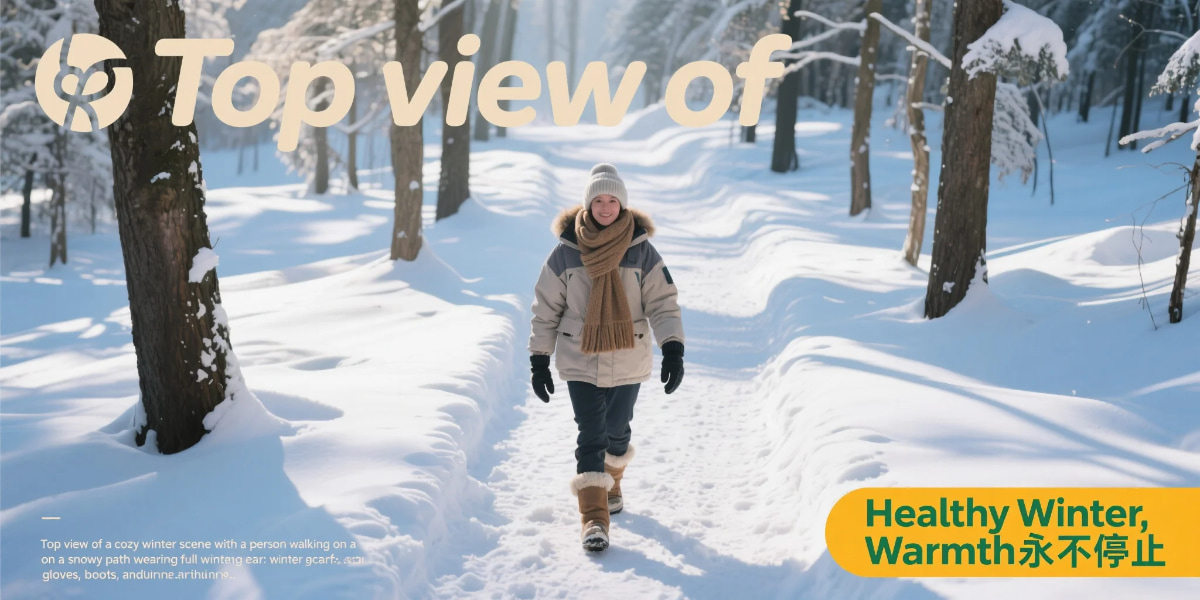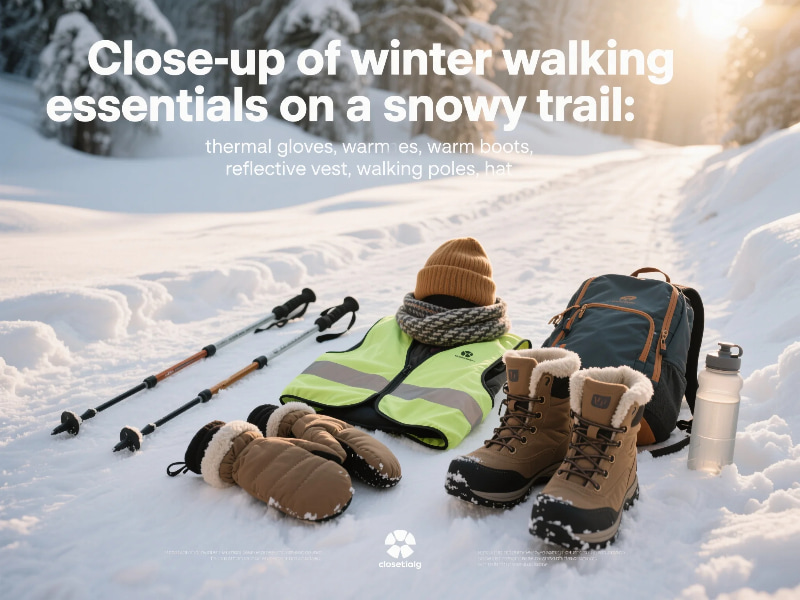❄️ Winter Walking Tips for Safety & Health

Walking outdoors during winter offers numerous health and fitness benefits, including improved circulation, better mood, stronger immunity, and calorie burn. However, cold temperatures, icy surfaces, and snow-covered paths can increase risk of slips, falls, and injuries. By following expert Winter Walking Tips for Safety & Health, you can enjoy outdoor exercise safely, even during the coldest months. Proper clothing, safe footwear, route planning, hydration, and warming up are critical components of a safe winter walking routine. Residents across the USA, Canada, the UK, and Europe can benefit from this detailed guide covering essential gear, safety strategies, and wellness tips for walking in winter conditions.
🥾 Essential Winter Walking Gear Winter Walking Tips for Safety & Health
Proper gear ensures safety, warmth, and comfort while walking outdoors in cold months. Choosing the right clothing, footwear, and visibility accessories minimizes the risk of slips, falls, and cold-related injuries. Investing in high-quality winter walking equipment enhances your overall winter walking experience.
🧤 Layered Clothing for Warmth Winter Walking Tips for Safety & Health
Layering clothing is crucial to prevent hypothermia and frostbite. Start with moisture-wicking base layers, add insulating mid-layers like fleece, and finish with waterproof outer layers. Thermal socks, insulated gloves, and scarves help maintain body heat during long walks. Choose breathable fabrics to avoid overheating while walking vigorously in cold weather. Layering clothing is crucial to prevent hypothermia and frostbite during winter walks. Start with moisture-wicking base layers, add insulating mid-layers, and finish with waterproof outer layers to stay dry. Thermal socks, gloves, scarves, and hats help maintain body heat while allowing flexibility and comfort during brisk walkingWinter Walking Tips for Safety & Health.
👟 Footwear for Slippery Conditions Winter Walking Tips for Safety & Health
Non-slip boots, traction cleats, and anti-skid soles reduce slip risk. Walking poles or trekking sticks can provide extra stability on icy or uneven surfaces. Check footwear regularly for wear and tear and replace them before the winter walking season begins. Winter Walking Tips for Safety & Health Proper winter footwear provides traction, stability, and protection from icy surfaces. Non-slip boots, traction cleats, and anti-skid soles are essential to reduce the risk of slips. Walking poles or trekking sticks further enhance balance and confidence on snowy or uneven pathways.
🦺 Visibility & Safety Accessories
Layering clothing is crucial to prevent hypothermia and frostbite during winter walks. Start with moisture-wicking base layers, add insulating mid-layers, and finish with waterproof outer layers to stay dry. Thermal socks, gloves, scarves, and hats help maintain body heat while allowing flexibility and comfort during brisk walking.
👟 Footwear for Slippery Conditions
Proper winter footwear provides traction, stability, and protection from icy surfaces. Non-slip boots, traction cleats, and anti-skid soles are essential to reduce the risk of slips. Walking poles or trekking sticks further enhance balance and confidence on snowy or uneven pathways.
🦺 Visibility & Safety Accessories Winter Walking Tips for Safety & Health
Reflective vests, LED lights, and brightly colored clothing improve visibility in low-light winter conditions. Carry a phone for emergencies and consider wearing ID tags. Safety accessories ensure you remain visible to motorists and other pedestrians during early morning or evening walks. Being visible in low-light winter conditions is critical for safety. Reflective vests, LED lights, and brightly colored clothing increase visibility to motorists and other pedestrians. Carrying a phone and wearing identification ensures help is available in case of emergencies.
🏃 Preparing Your Body for Cold Weather Winter Walking Tips for Safety & Health
Preparing your body before stepping outside improves safety, enhances performance, and reduces the chance of injuries. Cold muscles are prone to strains and fatigue, so warm-up exercises, gradual acclimation, and off-trail strengthening are essential. A strong, prepared body allows you to enjoy winter walking confidently and safely.
🔄 Warm-Up Exercises Before Walking Winter Walking Tips for Safety & Health
Cold muscles are more prone to injury. Stretch calves, hamstrings, ankles, and hip flexors before stepping outside. Perform dynamic stretches and gentle joint rotations to improve circulation and reduce injury risk. Cold muscles are more susceptible to injuries, making proper warm-ups essential. Stretch calves, hamstrings, ankles, and hip flexors to increase circulation and flexibility. Incorporate dynamic stretches and gentle joint rotations to prepare your body for cold-weather walking.

⏱️ Gradual Start & Short Distances
Begin with shorter walking sessions and increase distance gradually. This allows your body to adapt to cold temperatures, prevents overexertion, and reduces the risk of muscle strain or fatigue. Start with shorter walks to allow your body to adapt to cold temperatures. Gradually increase distance and pace to prevent fatigue or strain. This approach ensures your muscles, joints, and cardiovascular system adjust safely to winter conditions.
💪 Strengthening Exercises Off the Trail
Incorporate indoor strength exercises to maintain balance and stability. Core and leg exercises improve walking efficiency and reduce slips or falls during winter walks. Incorporate indoor strength exercises to enhance balance, stability, and endurance. Core and leg exercises improve walking efficiency and reduce slips or falls. Maintaining off-trail strength is essential for safe winter walking over icy or uneven terrain.Winter Walking Tips for Safety & Health
🌨️ Safe Winter Walking Practices
- Walk on cleared or salted pathways whenever possible.
- Avoid shaded areas where black ice may form.
- Use walking poles for stability on icy trails.
- Keep your hands free to maintain balance.
- Inform someone of your walking route if walking alone.
- Wear warm gloves and hats to prevent frostbite.
- Check weather forecasts before heading out to avoid storms.
- Carry a small backpack with water, snacks, and safety items.
- Take shorter steps on ice and snow to reduce slipping risk.
- Listen to your body and return indoors if you feel too cold.
Walking safely during winter requires careful planning, awareness, and adherence to precautionary measures. By following expert strategies, you can minimize accidents, prevent injuries, and enjoy winter walks comfortably. Safety practices include route selection, proper steps, and mindful pacing to handle icy or snowy conditions.
❄️ Path & Route Selection
Always choose cleared or salted pathways whenever possible. Avoid shaded areas where black ice may form. Planning your route ensures a safer walking experience and reduces exposure to hazardous conditions.
🏔️ Balance & Stability Tips
Use walking poles for additional stability on icy or uneven surfaces. Keep your hands free to maintain balance. Short, controlled steps help prevent slips and maintain confident movement during winter walks.
🕒 Timing & Weather Awareness
Check weather forecasts before heading out and avoid walking during storms or extreme cold. Walk during daylight hours when visibility is better, and always inform someone of your route if walking alone.
🍏 Health Tips During Winter Walks
- Stay hydrated; cold weather increases water loss through respiration.
- Snack on high-energy foods like nuts, fruits, or energy bars.
- Dress in breathable layers to prevent overheating during brisk walking.
- Monitor walking duration to prevent frostbite or hypothermia.
- Maintain upright posture and steady pace for cardiovascular benefits.
- Include mindfulness to reduce stress and enhance mental wellness.
Maintaining proper health during winter walking ensures that your outdoor activity is both safe and effective. Hydration, nutrition, layering, and posture are critical components for preventing cold-related issues while maximizing fitness benefits.
💧 Hydration & Nutrition
Cold weather increases water loss through respiration, so stay hydrated. Consume high-energy snacks like nuts or fruits to maintain energy levels during winter walks. Proper hydration and nutrition sustain endurance and prevent fatigue. Winter Walking Tips for Safety & Health
🧘 Mindful Walking & Posture
Maintain upright posture, controlled pace, and mindful walking to reduce the risk of injuries. Focus on breathing and walking rhythm to enhance cardiovascular benefits. Mindfulness during winter walks also improves mental wellness and reduces stress.
⏳ Duration & Frequency
Limit walking sessions based on weather and personal tolerance. Gradually extend duration as your body adapts to cold. Consistent winter walking, when done safely, contributes to long-term health and fitness goals.
❓ FAQs
Q1: How long should I walk in cold weather?
A1: Begin with 15–20 minutes and gradually increase duration while monitoring your body for signs of cold stress.
Q2: What clothing is best for winter walking?
A2: Use moisture-wicking layers, insulated mid-layers, and waterproof outerwear. Gloves, scarves, and hats are essential.
Q3: How can I prevent slips on ice?
A3: Wear boots with traction, use walking poles, and walk slowly with shorter steps on icy surfaces.
Q4: Can winter walking improve mental health?
A4: Yes. Exposure to daylight, fresh air, and nature reduces stress, improves mood, and boosts mental wellness.
Q5: Is a warm-up necessary before walking in winter?
A5: Absolutely. Cold muscles are more prone to injury; warm-ups increase circulation and flexibility.
📣 Call to Action
Implement Winter Walking Tips for Safety & Health today. Equip yourself with proper clothing, footwear, and safety gear. Plan your route and stay aware of weather and trail conditions. Share this comprehensive guide with friends and family to encourage safe and healthy winter walking habits.
📝 Conclusion
Winter walking is a safe, effective way to maintain fitness, mental wellness, and immune health when done correctly. Following Winter Walking Tips for Safety & Health — including proper gear, warm-up routines, safe walking practices, and hydration — ensures an enjoyable and injury-free experience. Residents across the USA, Canada, the UK, and Europe can safely enjoy crisp winter walks, gain cardiovascular benefits, and boost mood during the colder months. Consistent winter walking strengthens muscles, improves circulation, and promotes mental clarity, making it a holistic fitness strategy.
Related
Discover more from Ecofriendly
Subscribe to get the latest posts sent to your email.

